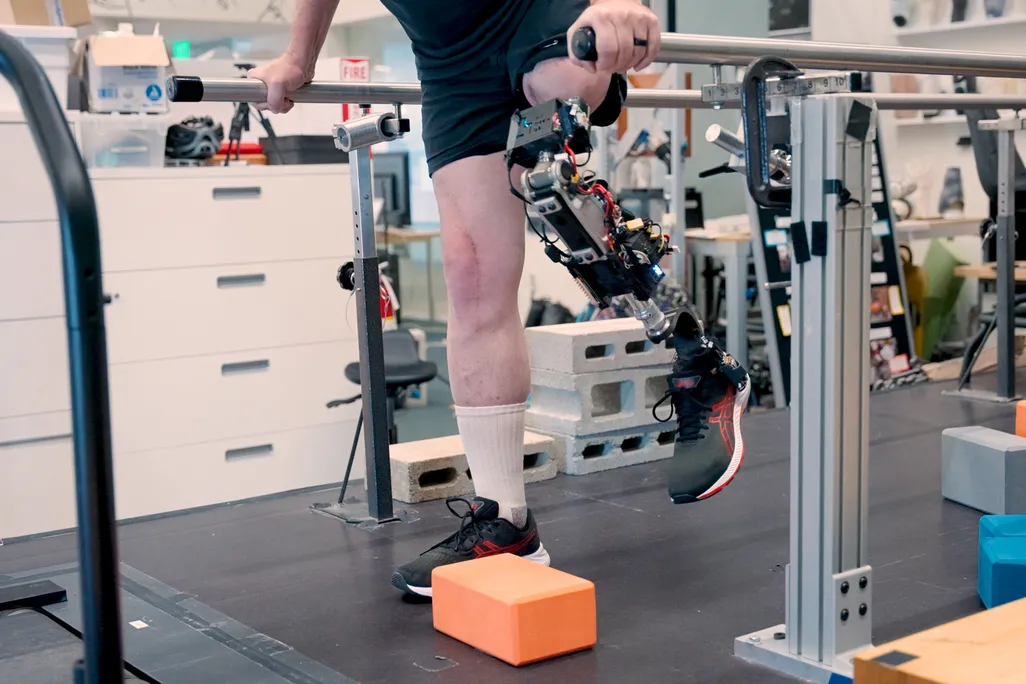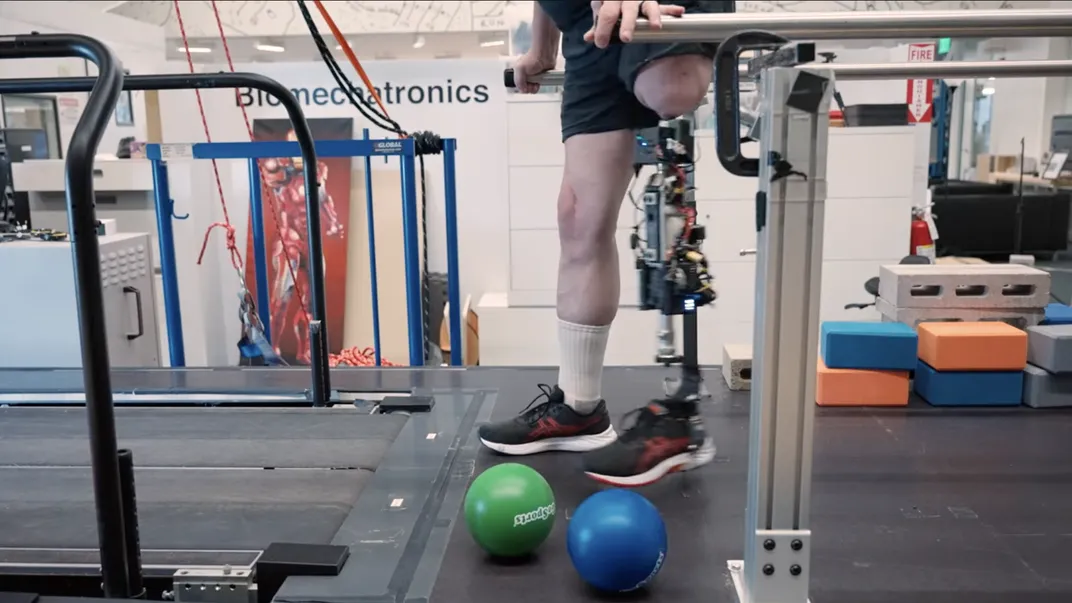Reliable. Secure. Since 2012. Exchange Crypto Sign up to get a trading fee discount!
Transform bandwidth into earnings with GetGrass

This New Bionic Knee Is Changing the Game for Lower Leg Amputees
Scientists have developed a prosthesis that is directly integrated with muscle and bone in order to improve movement

A patient with the new prosthesis walks over an obstacle.
Courtesy of the researchers, MIT
Key takeaways: New bionic knee
- Amputees have been outfitted with a prosthesis that is integrated with muscle and bone.
- The new creation allows patients to walk faster and avoid obstacles better than they could with past prostheses.
Biomechanists have just created a revolutionary bionic knee that helps amputees with a remarkable range of movement. Traditionally, lower leg prostheses are an external device. An amputee’s stump is fixed with a socket upon which a robotic limb is attached. But now, researchers at MIT have developed a prosthesis that is directly connected to a patient’s bone and muscle tissue, and it feels more like a part of their own body.
Since 2017, a team of scientists at MIT’s Yang Center for Bionics—co-led by biomechanist Hugh Herr—have been working to develop better, more advanced prostheses that are integrated into an amputee’s body. In a new study published last month in Science, the researchers have brought together different technologies to create a tissue-integrated, above-the-knee prosthesis that gives people more control over their movements.
“We actually are pushing the definition of what a prosthesis can be, and that’s why we say it’s a tissue-integrated prosthesis,” Tony Shu, lead author of the study, says. “There’s a part that you will never be able to take off without another surgery.”
Shu likes to think of the new prosthesis as a culmination of three layers.
The first of these such layers is at the neuromuscular level. In an able-bodied person, Shu explains, at least two muscles pull against each other to move a joint, a relationship researchers refer to as “agonist-antagonist”—or the phenomenon in which one muscle stretches as another contracts. This relationship is what creates proprioception, or the sense that even when you close your eyes and move your elbow, for example, you know where your arm is in space.
In a traditional amputation, this relationship is disrupted, and severed muscles are simply used to pad the prosthetic socket, disrupting one’s sense of control and proprioception. However, when a surgery is conducted to reconnect severed muscles—what researchers call an agonist-antagonist myoneural interface, or AMI—the muscles’ natural relationship to each other is restored. In 2024, the MIT lab showed that below-the-knee amputees who had received this special surgery had better control than traditional amputees.
This time, Herr’s team took such advancements a step further, combining the surgery with the second layer of the new prosthesis. A titanium rod was inserted into an amputee’s residual bone—in this case, a femur bone above the knee—to allow for more comfort and better movement control compared to the traditional socket. The addition also enabled better load bearing. In the past, the prosthesis would put pressure on soft tissue instead of bone, creating discomfort for amputees. “Imagine sweating into a hard carbon fiber shell all day and the chafing as your residual limb slides up and down the socket,” Shu explains.
Additionally, wires were connected to electrodes implanted within muscle tissue. These wires were then routed to the external robotic controller that helps move the prosthesis.
The third layer of the prosthesis is what Shu refers to as the “mechatronics layer,” or the robotic limb that is then attached directly to the titanium implant. According to Shu, this robotic limb is but a secondary feature to the two other prosthetic layers that are integrated into the body: “If there’s a better leg that comes out five years in the future, you can upgrade,” Shu says. “You can replace the system with a faster, better leg, and you still have all the control aspects.”
The researchers collaborated closely with surgeons at Mass General Brigham to test the new device in two subjects. These subjects were then compared with eight subjects who had received only the AMI surgery and seven subjects who had received neither the surgery nor the bone integration system.
Using the same knee prosthesis on all subjects, the scientists then measured their abilities to perform certain tasks, such as ascending and descending stairs and avoiding obstacles while walking. The team found that, especially in more agile tasks, the two subjects who had all three prosthetic layers performed better.
In addition to measuring patients’ ability to control their prostheses, researchers also measured their sense of embodiment. In short, embodiment includes the feeling that the prosthetic is a part of a patient’s body and that the individual has agency with it—that the prosthetic performs the tasks an individual intends it to.
In order to quantify patients’ sense of embodiment, researchers distributed a questionnaire that asked subjects whether they felt that they had agency, ownership and control over their prostheses. The two subjects who had received both the special surgery and the implant system reported a significantly higher level of embodiment.
“Embodiment is actually hugely critical for patient well-being,” Shu says, adding that while the phenomenon has been studied in upper limb amputees, it has been entirely neglected in lower limb amputees. “This is one of the first studies that really actually asks a lower limb amputee, ‘How do you feel about your prosthesis?’”
The new system is directly integrated with the user’s muscle and bone tissue to provide better control of the prosthesis. Courtesy of the researchers; MIT News/https://tf-cmsv2-smithsonianmag-media.s3.amazonaws.com/filer_public/8e/4f/8e4f6618-3960-40c9-b0cf-51a1d64a38b8/mit_bionic-knee-01-press.jpg)
John Brinkmann, a prosthetist-orthotist at Northwestern University’s Feinberg School of Medicine, says that the findings of the MIT lab are a step forward in integrating a device with a patient, noting that such integration technologies are far less common for lower limb amputees.
But Brinkmann, who was not involved in the study, emphasizes that cost might be a huge challenge to more widespread commercial use, explaining that patients have already faced problems getting traditional prosthetics covered by insurance.
“There’s also medical criteria,” says Brinkmann. “There are some patients who may not qualify for these types of procedures just because of their medical conditions.”
According to Paul Marasco, a sensory-neural physiologist at the Cleveland Clinic who was not involved in the study, patients considering the new technology will also have to think about the recovery time. They will have to consider whether the invasive nature of the surgery and time to get used to the device is worth its improvement in functionality and embodiment.
For Marasco, the fact that the researchers were able to generate a stronger sense of agency was particularly exciting. This increase in agency, he says, is directly tied to how much a patient is able to trust their prosthesis.
Joan Sanders, a biomechanist at the University of Washington who was not involved in the study, says that in the past few years researchers have been working to get the neurological system more involved with prosthetic devices, as the team at MIT have done in this new study. She says that the practice of involving the mind more started with upper limb patients and is just beginning in lower limb ones.
According to Shu, in the field of prosthetics, two schools of thought exist. One is that the prosthesis itself should be made as smart as possible—affixing it with artificial intelligence, sensors and more that can enable the prosthesis to “think for itself” without much human input. Patients can walk upstairs and avoid obstacles at a high level of function, but in this approach, Shu says, embodiment is lacking.
The other school of thought—which Shu and the team at MIT subscribe to—focuses more on giving humans back control and creating prostheses that feel more like part of the body. Shu says that this integration is essential to unlock the last 5 percent of human performance—for example, enabling someone with a prosthesis to go from a stand-still to immediately being able to dance.
The MIT lab has been moving toward the direction of integrating prostheses with the human mind since 2013. The team is now even researching technology that can give patients a sense of touch. “I want to be in the business of building bodies, not powerful devices,” Herr says. “I want to fully integrate humanity into electromechanics, not just build a better hammer.”
Source link Report Story






